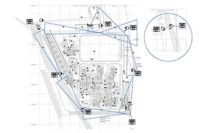

SDM:What percentage of your jobs involve integrated systems and who’s buying them?
Clark:We probably do more than 80 percent of our work with some form of system integration. We typically will appeal to the larger user — facilities such as hospitals, large manufacturing facilities, cities and state-based systems. But we’ll take a look at smaller applications as well, such as convenience stores or small retail establishments.
SDM:What developments are you seeing involving integrated systems?
Clark:Until recently, all security camera video has been based on early 1980s technology. But very recently, there have been several firms that have introduced new technology, high-definition cameras, and all of a sudden the level of detail in the average video picture has been raised by a factor of three or four times.
For the first time in the industry’s history, we can drill down into the video in a forensics style of investigation after the fact, and see detail that wasn’t available with the older technology. Additionally. with new high-definition and megapixel cameras, you can digitally zoom in on portions of the recorded video and see so much more — like license plates, facial features and hand movements.
SDM:What are your biggest challenges?
Kobelin:One is educating customers on the benefits of using technology. We just conducted a CCTV forum to show the new technology and to help people understand that there are new products available and they don’t have to settle for the low resolution of the older technology cameras.
We conduct these forums and workshops at least once a year. We invite groups of potential end users, consultants and engineers. We’ve learned that offering our end users the opportunity to spend a half day learning about the new technology applications is the best way to educate them about all the options they have to build a better system for their unique needs.
SDM:What are your biggest opportunities today?
Clark:In every vertical market, there are unique opportunities and restrictions in our business. For example, hospitals now face growing threats of violence in their emergency departments. But when electronic security systems are installed in hospitals, the installer must deal with a host of dust and infection control procedures every time they remove a ceiling tile.
This requires the installer to build a protective tent around the tile and use evacuation pumps with filters to contain the dust and other airborne contaminants. So even though systems can be applied to multiple vertical markets, we find we have to have installation specialists within each vertical market to deal with the unique challenges that will be encountered.
SDM:What are you doing to achieve satisfactory profit margins?
Clark:It’s always a fine balance. When we come into a bidding situation where we think there’s going to be a lot of decisions made strictly on the basis of low price, we often will not bid that job. These electronic systems are complex enough that rarely does the bid specification reflect all that the customer really needs. Often, we find ourselves providing considerable value engineering support in order to design the type of security system that will meet the customer’s needs.
A better approach is to use the “evaluation matrix” in an RFP. In an “evaluation matrix,” the customer has the opportunity to evaluate several factors, such as price, system performance, installer experience, etc. Each factor can be weighted differently.
They can then award the system to the firm that ranks highest (on their matrix) in meeting their needs. We are finding that even state and government agencies that used to go out for “only low bid” now include an evaluation matrix in their RFPs.

